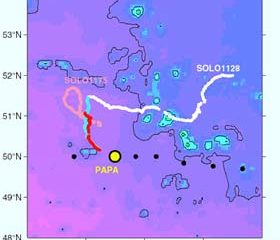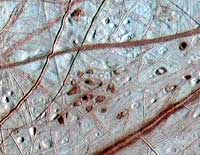Search Results for: ocean

Asian dust storm causes plankton to bloom in the North Pacific
Robotic Carbon Explorers test the “iron hypothesis” in nature
In the spring of 2001, two robotic Carbon Explorer floats recorded the rapid growth of phytoplankton in the upper layers of the North Pacific Ocean after a passing storm had deposited iron-rich dust from the Gobi Desert. The carbon measurements, reported in the October 25 issue of Science, are the first direct observation of wind-blown terrestrial dust fertilizing the growth of aquatic plant life.
A group of scie

Colorado U. space team studying water, ice and potential life on Jupiter moon, Europa
The oozing of glacial material in the floating ice shell on Jupiter’s moon Europa has important implications for future exploration of the enigmatic moon and prospects of life in its ice-covered ocean, according to a University of Colorado at Boulder professor.
Robert Pappalardo, an assistant professor in the astrophysical and planetary sciences department and one of the world’s foremost Europa experts, said the icy moon is believed to contain an ocean some 13 miles under its icy
Increasingly salty Mediterranean favors ice sheet growth
About 150,000 years ago, an anomalous ice age was triggered by an increasingly salty Mediterranean Sea, a development that’s occurring today and may start new ice sheet growth in the next few decades, according to a study at the University of Minnesota. Robert Johnson, an adjunct professor of geology and geophysics, will present his study of the glaciation 150,000 years ago and discuss its implications for today’s climate on Tuesday, Oct. 29, at the annual meeting of the Geological Society
New Findings Reconfirm Toxicity of Pfiesteria Cultures
A team of experts has refuted previous findings published last summer stating that Pfiesteria is not toxic to fish or humans. When they cultured the same strain of P. shumwayae studied by the dissenting scientists, it produced a toxin that killed fish within minutes.
Dr. JoAnn Burkholder, director of North Carolina State University’s Center for Applied Aquatic Ecology, presented the results of the new study Tuesday at the 10th International Conference on Harmful Algae in S
Giants joust in the cold
A new giant was born recently in the coastal waters of Antarctica. A series of images captured from May through the beginning of this month by ESA`s Envisat satellite shows the subsequent duel between the new iceberg and another as it breaks free of the Ross Ice Shelf and tries to move north.
Christened C-19 by the US National Ice Centre in Maryland, the new iceberg measured 200 x 32 km, and about 200 m thick.
As seen in the accompanying animation of images acquired by Envi
Melting crust makes rich gold, copper deposits
A U of T study suggests why giant gold and copper deposits are found at some volcanoes but not others, a finding that could point prospectors to large deposits of this and other valuable metals.
“There’s one characteristic that is common to all of these big gold and copper deposits anywhere in the world,” says Professor James Mungall of the Department of Geology. The ocean’s crust that is pushed down under a volcano can start to melt, which it doesn’t normally do. His study, which appea